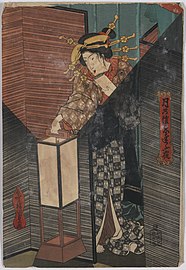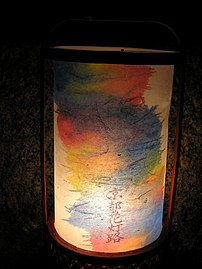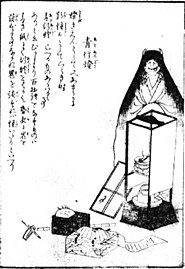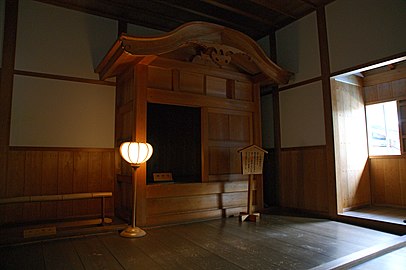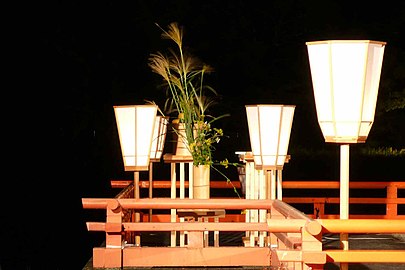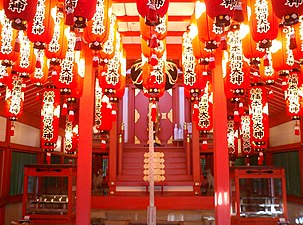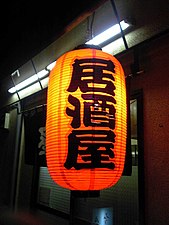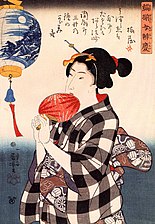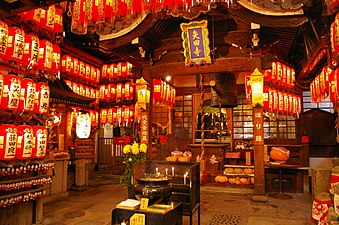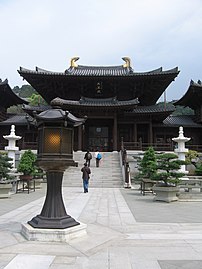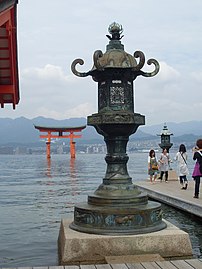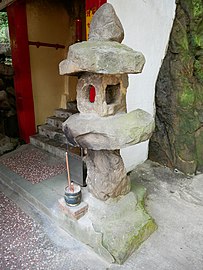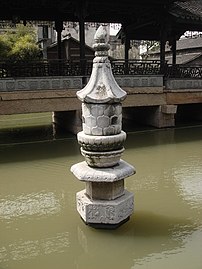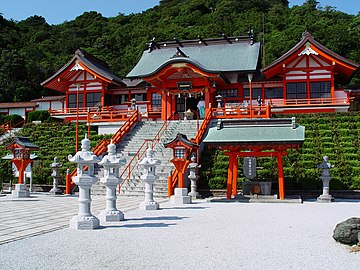Traditional lighting equipment of Japan
From Wikipedia, the free encyclopedia
The traditional lighting equipment of Japan includes the andon (行灯), the bonbori (雪洞), the chōchin (提灯), and the tōrō (灯篭).

Andon
Summarize
Perspective
The andon is a lamp consisting of paper stretched over a frame of bamboo, wood or metal.[1] The paper protected the flame from the wind. Burning oil in a stone, metal, or ceramic holder, with a wick of cotton or pith, provided the light. They were usually open on the top and bottom, with one side that could be lifted to provide access.[2] Rapeseed oil was popular. Candles were also used, but their higher price made them less popular. A lower-priced alternative was sardine oil.
The andon became popular in the Edo period (1603–1867).[1] Early on, the andon was handheld; it could also be placed on a stand or hung on a wall.[3] The okiandon was most common indoors. Many had a vertical box shape with an inner stand for the light. Some had a drawer on the bottom to facilitate refilling and lighting. A handle on top made it portable. A variety was the Enshū andon. One explanation attributes it to Kobori Enshu, who lived in the late Azuchi-Momoyama period and early Edo period. Tubular in shape, it had an opening instead of a drawer.[4] Another variety was the Ariake andon, a bedside lamp. The kakeandon under the eaves of a shop, often bearing the name of the merchant, was a common sight in the towns.
The expression hiru andon, or "daytime lamp," meant someone or something that seemed to serve no purpose.[5] In dramatizations of the story of the forty-seven ronin, Oishi Yoshio is often given this description.
- Ukiyo-e print showing an andon being carried indoors
- An andon standing outdoors with one side open
- Andons hung in Mishima, Shizuoka
Bonbori
The bonbori (雪洞) is a kind of Japanese paper lamp used in the open during festivals. It normally has an hexagonal profile and a rather wide, open top.[6] It can either hang from a wire or stand on a pole. Famous is the Bonbori Festival (ぼんぼり祭り, Bonbori Matsuri), held annually at Tsurugaoka Hachiman-gū in Kamakura, Kanagawa. Artists paint on the about 400 bonbori erected for the occasion on the shrine's grounds.[7]
- Bonbori lining the Sandō at a Bonbori Festival
- Yōkōkan Teien (養浩館庭園) in Fukui
Chōchin
A relative of the Chinese paper lantern, the chōchin has a frame of split bamboo wound in a spiral. Paper or silk protect the flame from wind. The spiral structure permits it to be collapsed into the basket at the bottom.[8] The chōchin is used outdoors, either carried or hung outside the house.[1] In present-day Japan, plastic chōchin with electric bulbs are produced as novelties, souvenirs, and for matsuri and events.[9] The earliest record of a chōchin dates to 1085,[8] and one appears in a 1536 illustration.
The akachōchin, or red lantern, marks an izakaya.[10] In Japanese folklore, the chochin appears as a yōkai, the chōchin-obake.[11]
Gifu is known for its Gifu lanterns, a kind of chōchin made from mino washi.[12]
- Chōchin at Minatogawa Shrine in Kōbe
- White chōchin decorated with tomoe
- Akachōchin lantern outside an izakaya
- Yata-dera (矢田寺) Temple in Kyōto
- Gifu chōchin
- Massive chōchin at Isshiki Manabi no Yakata museum
Tōrō
Originally used in the broad sense to mean any lantern, the term tōrō came to refer to a lamp of stone, bronze, iron, wood, or another heavy material. These illuminate the grounds of Buddhist temples, Shinto shrines, Japanese gardens, and other places that include tradition in their decor.[1] The earlier use of oil and candles has in the modern day been replaced by electric bulbs.
Bronze tōrō
- Bronze and stone lanterns in Chi Lin Nunnery, Hongkong
- Bronze lantern at Hōryū-ji
- 8th century bronze lantern at Tōdai-ji (National Treasure)
- Bronze lantern at Itsukushima Shrine
Stone tōrō
- Stone lantern in Taiwan
- Water lantern in Zhejiang Province
- Tachi-dōrō of the kasuga-dōrō type
- Three legged yukimi-dōrō. One leg rests on ground, two in water.
Wooden tōrō
- Wooden tōrō (黒木灯籠)
- Wooden tōrō placed between stone tōrō at Fukutokuinari shrine
See also
- Physalis alkekengi, the lantern plant
- Water lantern
- Gandō
References
External links
Wikiwand - on
Seamless Wikipedia browsing. On steroids.

